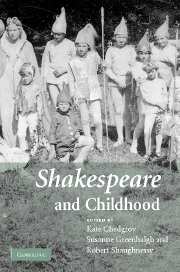Book contents
- Frontmatter
- Contents
- Acknowledgements
- Notes on contributors
- Note on the text
- 1 Introduction
- PART 1 SHAKESPEARE'S CHILDREN
- 2 Introduction: ‘What, are they children?’
- 3 Little princes: Shakespeare's royal children
- 4 Father-child identification, loss and gender in Shakespeare's plays
- 5 Character building: Shakespeare's children in context
- 6 Coriolanus and the little eyases: the boyhood of Shakespeare's hero
- 7 Procreation, child-loss and the gendering of the sonnet
- PART 2 CHILDREN'S SHAKESPEARES
- APPENDICES
- Index
7 - Procreation, child-loss and the gendering of the sonnet
Published online by Cambridge University Press: 22 September 2009
- Frontmatter
- Contents
- Acknowledgements
- Notes on contributors
- Note on the text
- 1 Introduction
- PART 1 SHAKESPEARE'S CHILDREN
- 2 Introduction: ‘What, are they children?’
- 3 Little princes: Shakespeare's royal children
- 4 Father-child identification, loss and gender in Shakespeare's plays
- 5 Character building: Shakespeare's children in context
- 6 Coriolanus and the little eyases: the boyhood of Shakespeare's hero
- 7 Procreation, child-loss and the gendering of the sonnet
- PART 2 CHILDREN'S SHAKESPEARES
- APPENDICES
- Index
Summary
When Anne Cecil de Vere, Countess of Oxford, died at the age of thirty-one two weeks after the birth of her fifth child in June 1588, Wilfred Samonde presented an elegy to her grieving parents. Their daughter was ‘for modesty a chaste Penelope’, he assured William Cecil, Lord Burghley and Mildred, Lady Burghley, and ‘another Grissel for her patience’. Samonde's conventional praise gains poignancy when considered in the light of Anne's difficult marriage to Edward de Vere, the seventeenth Earl of Oxford. The union, which began auspiciously in 1571, erupted notoriously after the birth of the couple's first child, Elizabeth. As rumour had it, Oxford had maintained before his departure for an extended tour of Europe in January 1575 ‘that if she [Anne] were with child it was not his’. He wrote to his father-in-law on his return to England in April 1576, approving of Burghley's suggestion that Anne return to the Cecil home, ‘for there as yowre doughter or her mothers more then my wife yow may take comfort of her and I rid of the comber therby, shall remaine well eased of many griefes’. The couple remained separated for six years. Anne gave birth to a son in 1583 – the promising product of his parents' reconciliation and the earl's first male heir – but hopes were quickly dashed when the infant died within three weeks of his birth.
- Type
- Chapter
- Information
- Shakespeare and Childhood , pp. 96 - 114Publisher: Cambridge University PressPrint publication year: 2007
- 1
- Cited by



